Intel SSD DC P3700 Review: The PCIe SSD Transition Begins with NVMe
by Anand Lal Shimpi on June 3, 2014 2:00 AM EST- Posted in
- Storage
- SSDs
- Intel
- Intel SSD DC P3700
- NVMe
Random Read Performance
Although sequential performance is important, a true staple of any multi-user server is an IO load that appears highly random. For our small block random read test we first fill all drives sequentially, then perform one full drive write using a random 4K pass at a queue depth of 128. We then perform a 3 minute random read run at each queue depth, plotting bandwidth and latency along the way.
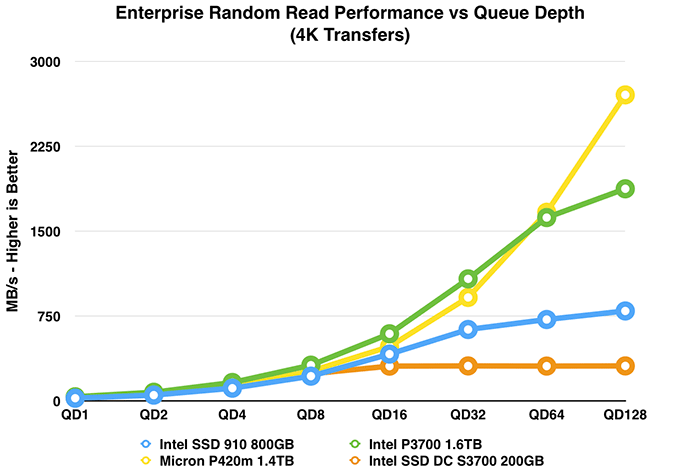
Small block random read operations have inherent limits when it comes to parallelism. In the case of all of the drives here, QD1 performance ends up around 20 - 40MB/s. The P3700 manages 36.5MB/s (~8900 IOPS) compared to 27.2MB/s (~6600 IOPS) for the SATA S3700. Even at a queue depth of 8 there's only a small advantage to the P3700 from a bandwidth perspective (~77000 IOPS vs. ~58400 IOPS). Performance does scale incredibly well with increasing queue depths though. By QD16 we see the P3700 pull away, at even as low as QD32 the P3700 delivers roughly 3.5x the performance of the S3700. There's a 70% advantage at QD32 compared to Intel's SSD 910, but that advantage grows to 135% at QD128.
Micron's P420m is incredibly competitive, substantially outperforming the P3700 at the highest queue depth.
Random read latency is incredibly important for applications where response time matters. Even more important for these applications is keeping latency below a certain threshold, what we're looking for here is a flat curve across all queue depths:
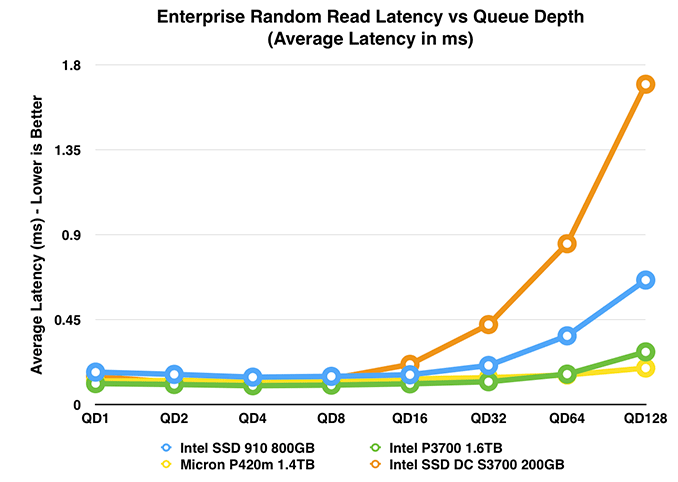
And that's almost exactly what the P3700 delivers. While the average latency for Intel's SSD DC S3700 (SATA) sky rockets after QD32, the P3700 remains mostly flat throughout the sweep. It's only at QD128 that we see a bit of an uptick. Even the 910 shows bigger jumps at higher queue depths.
If we remove the SATA drive and look exclusively at PCIe solutions, we get a better idea of the P3700's low latencies:
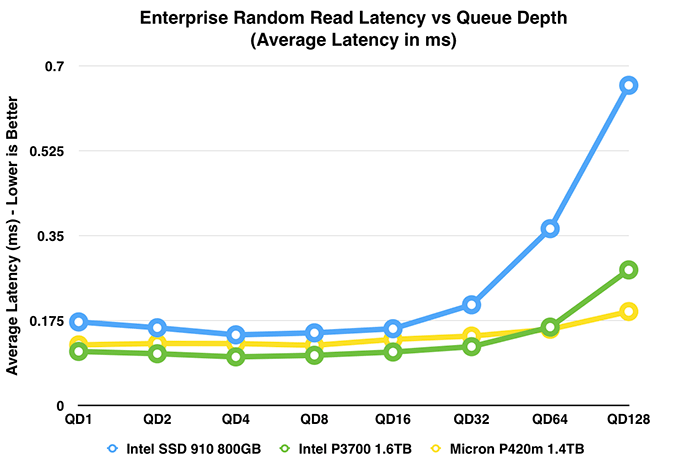
In this next chart we'll look at some specific numbers. Here we've got average latency (expressed in µs) for 4KB reads at a queue depth of 32. This is the same data as in the charts above, just formatted differently:
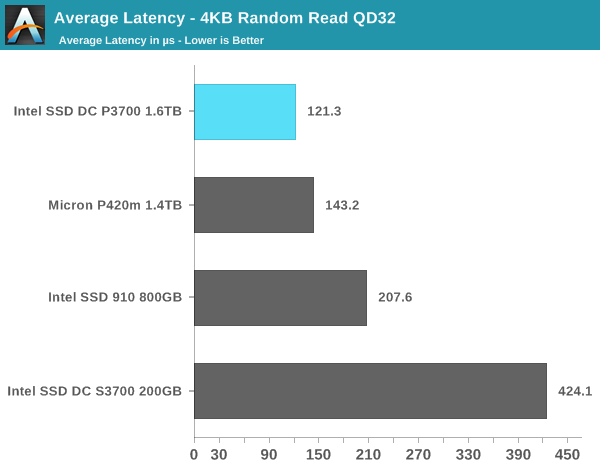
The P3700's latency advantage over its SATA counterpart is huge. Compared to other PCIe solutions, the P3700 is still leading but definitely not by as large of a margin. Micron's P420m comes fairly close.
Next up is average latency, but now at our highest tested queue depth: 128.
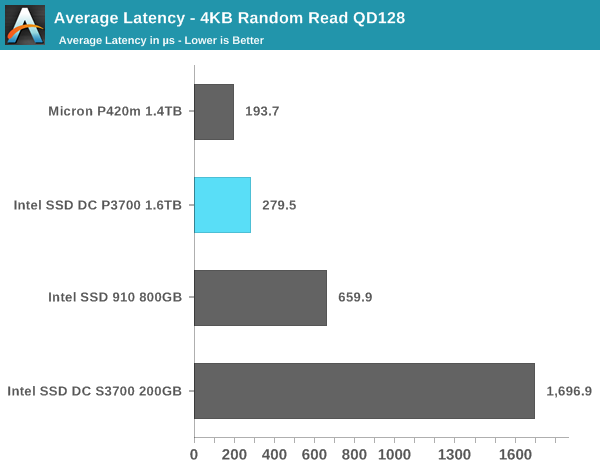
Micron's P420m definitely takes over here. Micron seems to have optimized the P420m for operation at higher queue depths while Intel focused the P3700 a bit lower. The SATA based S3700 is just laughable here, average completion latency is over 1.6ms.
Looking at maximum latency is interesting from a workload perspective, as well as from a drive architecture perspective. Latency sensitive workloads tend to have a max latency they can't exceed, but at the same time a high max latency but low average latency implies that the drive sees these max latencies infrequently. From an architectural perspective, consistent max latencies across the entire QD sweep give us insight into how the drive works at a lower level. It's during these max latency events that the drive's controller can schedule cleanup and defragmentation routines. I recorded max latency at each queue depth and presented an average of all max latencies across the QD sweet (From QD1 - QD128). In general, max latencies remained consistent across the sweep.
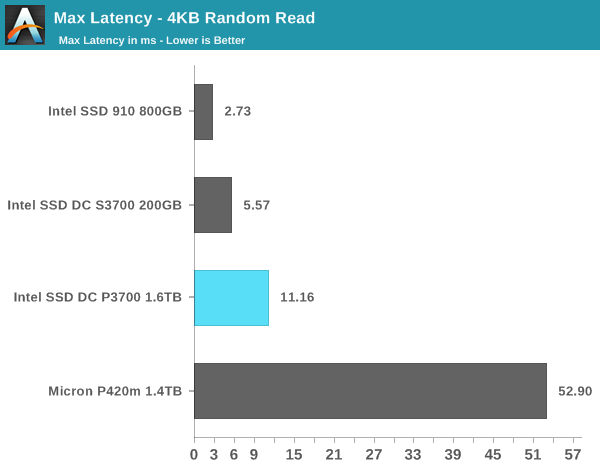
The 910's max latencies never really get out of hand. Part of the advantage is each of the 910's four controllers only ever see a queue depth of 32, so no individual controller is ever stressed all that much. The S3700 is next up with remarkably consistent performance here. The range of values the S3700 had was 2ms - 10ms, not correlating in any recognizable way to queue depth. Note the huge gap between max and average latency for the S3700 - it's an order of magnitude. These high latency events are fairly rare.
The P3700 sees two types of long latency events: one that takes around 3ms and another that takes around 15ms. The result is a higher max latency than the other two Intel drives, but with a lower average latency than both it's still fairly rare.
Micron's P420m runs the longest background task routine of anything here, averaging nearly 53ms. Whatever Micron is doing here, it seems consistent across all queue depths.
Random Write Performance
Now we get to the truly difficult workload: a steady state 4KB random write test. We first fill the drive to capacity, then perform a 4KB (QD128) random write workload until we fill the drive once more. We then run a 3 minute 4KB random write test across all queue depths, recording bandwidth and latency values. This gives us a good indication of steady state performance, which should be where the drives end up over days/weeks/months of continued use in a server.
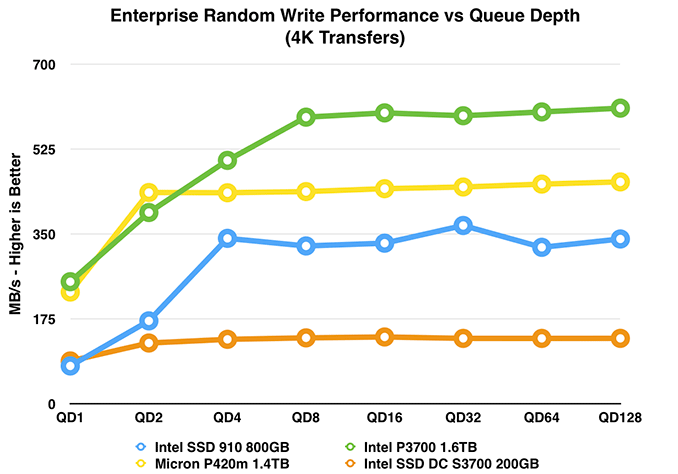
Despite the more strenuous workload, the P3700 absolutely shines here. We see peak performance attained at a queue depth of 8 and it's sustained throughout the rest of the range.
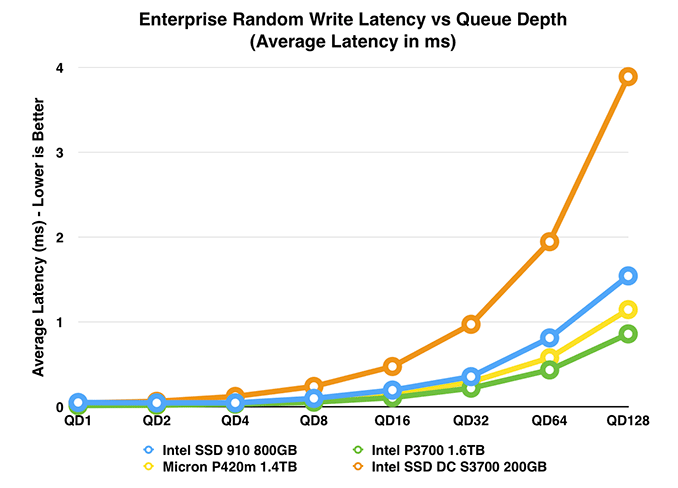
Average latency is also class leading - it's particularly impressive when you compare the P3700 to its SATA counterpart.
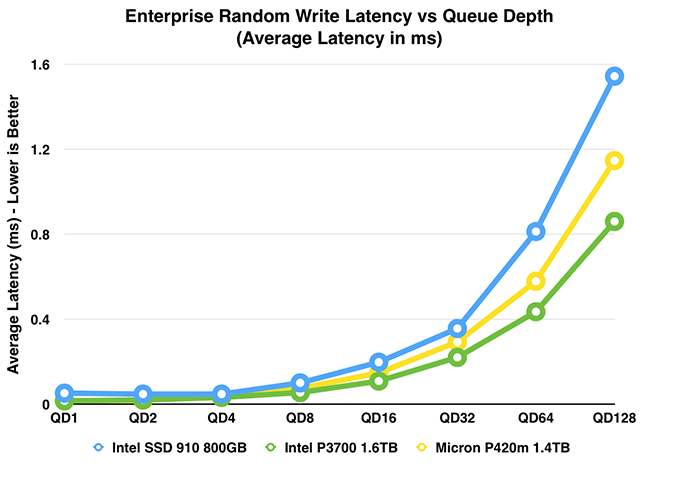
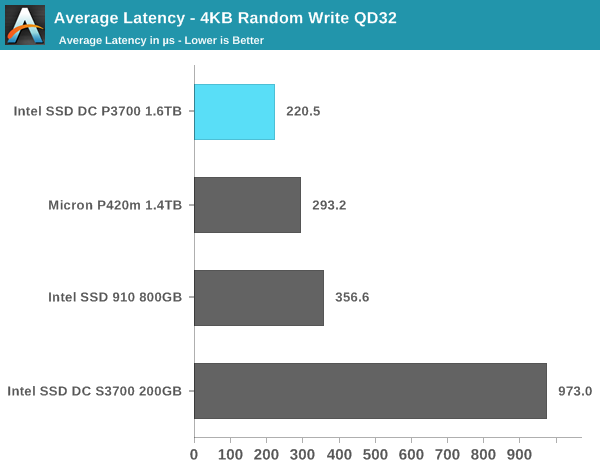

The absolute average latency numbers are particularly impressive. The P3700 at a queue depth of 128 can sustain 4KB random writes with IOs completing at 0.86ms.











85 Comments
View All Comments
Ammaross - Tuesday, June 3, 2014 - link
The M.2 SATA-protocol-on-PCIe drives? A comparison would mean Apple would need have to have support for NVMe first or the ability to even slot in such a card (rules out the 3 offerings you outlined).extide - Tuesday, June 3, 2014 - link
What are you talking about? "The M.2 SATA-protocol-on-PCIe drives?" doesn't even make sense.All you need to do to compare them is run the benchmarks on the apple hardware, possibly while running under a windows OS. OR, if the drives use the regular m.2 style connector you could just stick them in a desktop. The fact they run AHCI over PCIe does not make a comparison impossible, in fact all of the other PCIe cards in this review that were benchmarked against were also AHCI based cards. Seems like NVMe is confusing people at lot more than it should.
Galatian - Wednesday, June 4, 2014 - link
I think he tried to say that you can't stick one of those new NVMe drives into a Mac, since OS X does not yet support NVMe.That being said, Apple discontinued the old Mac Pro where you could put a PCIe device inside, so the point is moot no matter what.
gospadin - Tuesday, June 3, 2014 - link
I'd have liked to see the drive in 25W mode tooextide - Tuesday, June 3, 2014 - link
Yeah, I would as well. I am assuming the 25W mode has specific cooling requirements? More info on this would be nice. Also what is the default TDP?eanazag - Tuesday, June 3, 2014 - link
That's also the first thing I thought. I wanted to see the boost level. That bottom is pretty close to where I would consider splurging for my desktop with a 400GB. If you consider a RAID card and few drives then $600 is justifiable.I stayed away from the PCIe SSDs because of boot issues and quality concerns. A lot of those were OCZ.
Galatian - Tuesday, June 3, 2014 - link
I might have just overlooked it, but I guess those drives are not bootable?457R4LDR34DKN07 - Tuesday, June 3, 2014 - link
" Booting to NVMe drives shouldn't be an issue either."Galatian - Tuesday, June 3, 2014 - link
Ah great...so this might be a nice alternative to the lackluster state M.2 is right now after all!dopp - Tuesday, June 3, 2014 - link
NVMe won't necessarily be a replacement for M.2. M.2 is just the connector, and the M.2 standard supports both SATA and NVMe as protocols to control the SSD. That said, you need a motherboard that's wired to give PCIe-over-M.2 as well as a drive that supports NVMe, and NVMe M.2 drives will likely be much better than SATA ones.